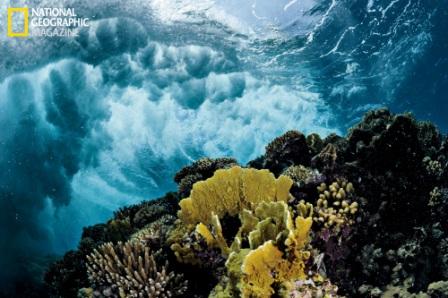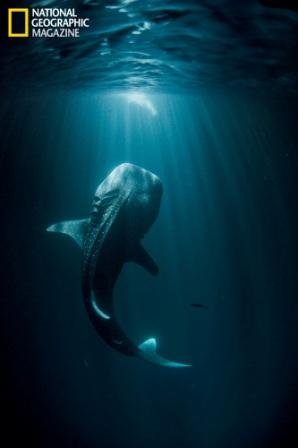
©Thomas P. Peschak/National Geographic, "Rarely visited, the reefs off Saudi Arabia in the northern Red Sea are some of the most undisturbed in the region. Sunlight penetrates deep into the clear waters, enabling lush gardens of corals to flourish along these wave-washed coasts." (This photo is in the March 2012 issue of National Geographic magazine, on newsstands February 28.)
There is one magazine that stands above the rest when it comes to stellar science writing, fascinating story telling and amazing photography: National Geographic. Reading National Geographic magazine is a portal into another world, a way to experience places you might never have the chance to visit, and a way to learn about people past and present. If you haven’t figured it out, I’m a big fan.
So when I received an email from National Geographic’s PR department asking if Ocean Wild Things readers would be interested in finding out about an ocean related piece in the magazine’s March edition, my response was yes! Reading ocean related articles in National Geographic magazine is one of the best ways to explore the underwater world by diving into astonishing underwater photography always accompanying groundbreaking research and riveting tales of the sea.
The March issue of National Geographic magazine features an article called “The Seas of Arabia,” written by Kennedy Warnes with stunning photographs by Thomas P. Peschak. The Arabian Seas are located in the northwest corner of the Indian Ocean surrounding the Arabian Peninsula and includes the Red Sea, the Gulf of Aden, the Persian Gulf and the Gulf of Oman. The reader is quickly drawn into a world that’s equal parts devastation and hope revealed through the death and life of the region’s marine life.
As with all ocean areas situated along heavily populated coasts, the challenges facing the Arabian Seas are staggering. This quote from the article sums it up best: Today human hands are reaching deep into Arabia’s seas and taking more treasure than the seas can possibly replenish. Overfishing, pollution, seabed dredging, and massive coastal modification are crippling marine ecosystems by degrading water quality and exacerbating toxic algal blooms. In 2010 a group of marine scientists described the region’s most strategic waterway, the Persian Gulf, as “a sea in decline,” bedeviled by a storm of malign influences. “If current trends continue,” they wrote, we will “lose a unique marine environment.”

©Thomas P. Peschak/National Geographic, "Fishermen's lights attract plankton, and plankton attract young whale sharks in Djibouti's coastal waters. In 2008, the United Arab Emirates banned whale shark fishing—a sign of growing awareness of the importance and vulnerability of Arabia's seas." (This photo is in the March 2012 issue of National Geographic magazine, on newsstands February 28.)
Human survival, ignorance and greed are driving the most destructive activities. This is best demonstrated by the mass overfishing of sharks exposed daily in the fish markets along Oman’s coast, where piles of dead sharks await their second life as shark fin soup in Asia. Local scientists and researchers know shark fishing isn’t sustainable, but raising awareness and reaching a consensus with local fishermen is extra difficult when there are eight different countries involved and governments that aren’t necessarily on the same page on religion and politics, much less fishing.
A researcher interviewed for the article explains the reactions she receives from fishermen on the topic of protecting sharks. Some say, No, why should we protect them? Sharks are a gift from God. He will replenish them. Others say that sharks should be protected but that it needs to happen across the region. If we protect them here, do you think the Iranians are going to stop taking them? they tell her. Why should I stop fishing for sharks and miss out on revenue if some other person keeps taking them?
In a surprising twist on revenue and profiting from the ocean’s resources, a bounty of marine life has recently been discovered near oil and gas fields in the Persian Gulf, including whale sharks! This is actually one of my favorite parts of the article because you will never guess how whale sharks are discovered…read the article to find out.

Image credit: National Geographic, March cover of National Geographic
As writer Kennedy Warnes explains, finding whale sharks was just the beginning: The discovery of whale sharks at Al Shaheen has led to other finds. Seasonal mass spawning of lobsters has been observed, with the lobsters rising to the surface at night and turning the sea into a vast crustacean soup. With fishing banned and boat traffic restricted in many oil and gas fields, these areas likely serve as de facto marine reserves.
Sightings of whale sharks and loads of lobsters are another sign of hope in a troubled ocean region. But are default marine reserves near potentially devastating oil and gas fields enough to protect marine life for future generations? Find out more about what countries and local groups are doing by reading the article on National Geographic’s website or pick up a copy of the March issue of the magazine and take a journey into the Arabian Seas. You won’t regret it.
(Note: I recommend picking up the magazine because it also has an excellent map of the region highlighting where certain types of ocean animals are found.)
Yet another great post! National Geographic is very smart to start collaborating with you, congrats!